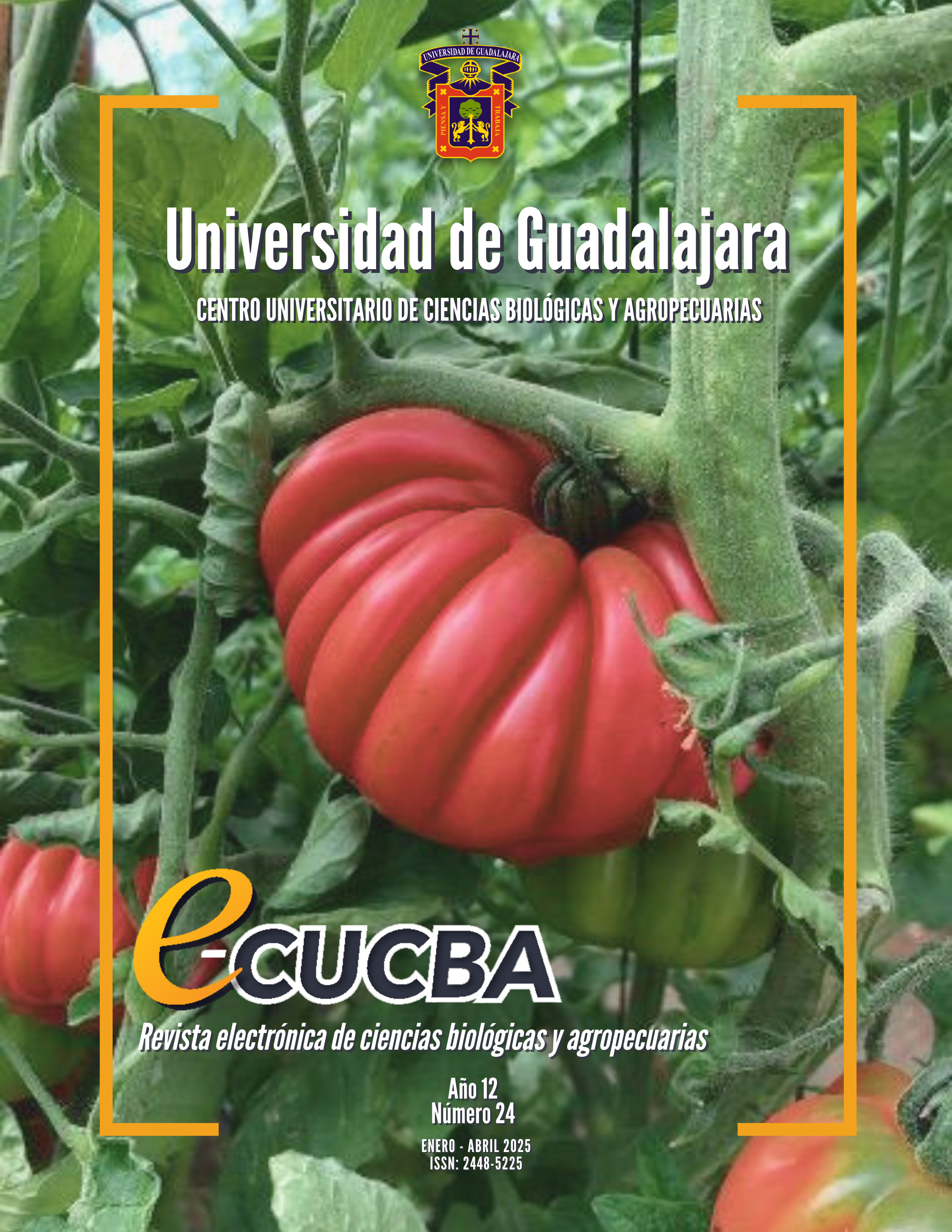Male leafhopper’s choice behavior in response to different maize and conspecific cues
Comportamiento de elección de la chicharra macho en respuesta a diferentes señales de maíz y de su misma especie
DOI:
https://doi.org/10.32870/e-cucba.vi24.371Palabras clave:
Olfactometer, chemical ecology, pests, odorsResumen
The corn leafhopper, Dalbulus maidis (Delong and Wolcott) (Hemiptera: Cicadellidae), is a significant pest of maize (Zea mays L.) across the Americas, particularly noted for its role in transmitting various phytopathogens. Although direct damage from sap ingestion is minimal, the economic impact of these pathogens has been severe, resulting in substantial yield losses. Despite the pest’s agricultural importance, little research has focused on its olfactory selection and the potential influence of volatile cues from host plants or conspecifics. This study investigated whether male D. maidis preferentially chose volatiles emitted from maize plants, conspecifics, or a combination of both. Behavioral observations carried out in a four-armed olfactometer revealed that male leafhoppers spent significantly more time in the arm containing the scent of both sexes than the arm with the scent of other males, although responses to female scents were not significantly different across treatments. We also did not found differences regarding the number of choices for the scented arm and the visit duration in response to different stimuli from plants. The results indicate a generally neutral choice towards the tested volatiles, suggesting that D. maidis males may rely more on other sensory inputs for host selection. This research lays the foundation for future studies on the chemical ecology of D. maidis, with implications for developing innovative pest management strategies.
Citas
Aguilera, S., Rodríguez-Escobar, J.G., Romero-González, V.N., Osorio-Acosta, F., López-Romero, G. Silva-Rosales, L. (2019). Identification and Abundance of Six Viruses and a Spiroplasma in Single and Mixed Infections in Maize Fields in Veracruz, Mexico. Revista Bio Ciencias, 6, e419. https://doi.org/10.15741/revbio.06.e419
Bernasconi, M.L., Turlings, T.C., Ambrosetti, L., Bassetti, P. y Dorn, S. (1998). Herbivore‐Induced Emissions of Maize Volatiles Repel the Corn Leaf Aphid, Rhopalosiphum maidis. Entomologia Experimentalis et Applicata, 87(2), 133-142. https://doi.org/10.1046/j.1570-7458.1998.00315.x
Bian, L., Cai, X.M., Luo, Z.X., Li, Z.Q. y Chen, Z.M. (2020). Foliage Intensity is an Important Cue of Habitat Location for Empoasca onukii. Insects. 11, 426. https://doi.org/10.3390/insects11070426
Chen, X. y Liang, A.P. (2015). Identification of a Self-Regulatory Pheromone System That Controls Nymph Aggregation Behavior of Rice Spittlebug Callitettix versicolor. Frontiers in Zoology, 12, 10. https://doi.org/10.1186/s12983-015-0102-4
Coll-Aráoz, M.V., Jacobi, V.G., Fernandez, P.C., Albarracin, E.L., Virla, E.G., Hill, J.G. y Catalan, C.A.N. (2019). Volatiles Mediate Host-Selection in The Corn Hoppers Dalbulus maidis (Hemiptera: Cicadellidae) and Peregrinus maidis (Hemiptera: Delphacidae). Bulletin of Entomological Research, 109(5), 633-642. https://doi.org/10.1017/S000748531900004X
Cook, D. (1994). Influence of Previous Mating Experience on Future Mating Success in Male Lucilia cuprina (Diptera: Calliphoridae). Journal of Insect Behavior, 8, 207-217. https://doi.org/10.1007/BF01988905
Czarnobai De Jorge, B., Meyhöfer, R., Jürgens, A. y Gross, J. (2023). Preference of Pear Psyllid (Cacopsylla pyri) for Specific Colour Inspires New Application in Plant Protection. Journal of Applied Entomology, 147(10), 976-989. https://doi.org/10.1111/jen.13194
Davidson-Lowe, E. y Ali, J. G. (2021). Herbivore-Induced Plant Volatiles Mediate Behavioral Interactions Between a Leaf-Chewing and a Phloem-Feeding Herbivore. Basic and Applied Ecology, 53, 39-48. https://doi.org/10.1016/j.baae.2021.03.005
de Oliveira, C.M. y Frizzas, M.R. (2021). Eight Decades of Dalbulus maidis (DeLong & Wolcott) (Hemiptera, Cicadellidae) in Brazil: What We Know and What We Need to Know. Neotropical Entomology, 51, 1-17. https://doi.org/10.1007/s13744-021-00932-9
Drosopoulos, S. y Claridge, M.F. (2006). Insect Sounds and Communication. Taylor & Francis Group, Boca Ratón, Florida, USA.
Erenstein, O., Jaleta, M., Sonder, K., Mottaleb, K. y Prasanna, B.M. (2022). Global Maize Production, Consumption and Trade: Trends and R&D Implications. Food Security, 14(5), 1295-1319. https://doi.org/10.1007/s12571-022-01288-7
Fritzsche Hoballah, M., Tamò, C. y Turlings, T.C.J (2002). Differential Attractiveness of Induced Odors Emitted by Eight Maize Varieties for the Parasitoid Cotesia marginiventris: Is quality or quantity important? Journal of Chemical Ecology, 28, 951-968. https://doi.org/10.1023/a:1015253600083
Finch, S. y Collier, R.H. (2000). Host Plant Selection by Insects- A Theory Based on Appropiate/Inappropiate landings by Pest Insects of Cruciferous Plant. Entomologia Experimentalis et Applicata, 96, 91-102. https://doi.org/10.1046/j.1570-7458.2000.00684.x
Guédot, C., Horton, D.R. y Landolt, P.J. (2009a). Attraction of Male Winterform Pear Psylla to Female-Produced Volatiles and to Female Extracts and Evidence of Male-Male Repellency. Entomologia Experimentalis et Applicata, 130, 191-197. https://doi.org/10.1111/j.1570-7458.2008.00807.x
Guédot, C., Millar, J., Horton, D. y Landolt, P.J. (2009b). Identification of a Sex Attractant Pheromone for Male Winterform Pear Psylla, Cacopsylla pyricola. Journal of Chemical Ecology, 35, 1437-1447. https://doi.org/10.1007/s10886-009-9725-2
Guédot, C., Horton, D.R. y Landolt, P.J. (2010). Sex Attraction in Bactericera cockerelli (Hemiptera: Triozidae). Journal of Chemical Ecology, 39, 1302-1308. https://doi.org/10.1603/EN10048
Hansson, B.S. (1999). Insect Olfaction. Springer-Verlag. Berlin, Germany.
Heady, S.E., Nault, L. R., Shambaugh, G. y Fairchild, L. (1986). Acoustic and Mating Behavior of Dalbulus Leafhoppers (Homoptera: Cicadellidae). Annals of the Entomological Society of America, 79, 727-736. https://doi.org/10.1093/aesa/79.4.727
Hermann, A. (2010). The Chemistry and Biology of Volatiles. John Wiley & Sons Ltd. West Sussex, United Kingdom.
Hill, J.G., Virla, E.G., Fernandez, P.C., Luft-Albarracin, E. y Coll-Aráoz M.V. (2023). Dalbulus maidis and Peregrinus maidis, both Phloem Feeding Hoppers, Induce Different Volatile Profiles in Maize. Consequences for a Natural Enemy. Journal of Pest Science, 97, 87–97. https://doi.org/10.1007/s10340-023-01612-w
Jones, T. K. L. y Medina, R. F. (2020). Corn Stunt Disease: An Ideal Insect–Microbial–Plant Pathosystem for Comprehensive Studies of Vector-Borne Plant Diseases of Corn. Plants, 9(6), 747. https://doi.org/10.3390/plants9060747
Liang, A.P. (2004). A New Tibial Gland in Male Spittlebugs with Descriptions of Two New Species of Augustohahnia Schmidt (Hemiptera: Cercopidae) from New Guinea. Journal of Zoology, 261, 173-180. https://doi.org/10.1017/S0952836903004072
Mazzoni, V., Ioriatti, C., Trona, F., Lucchi, A., Cristofaro, A. y Anfora, G. (2009). Study on the Role of Olfaction in Host Plant Detection of Scaphoideus titanus (Hemiptera: Cicadellidae) Nymphs. Journal of Economic Entomology, 102, 974-960. https://doi.org/10.1603/029.102.0316
Meiners, T. (2015). Chemical Ecology and Evolution of Plant–Insect Interactions: A Multitrophic Perspective. Current Opinion in Insect Science, 8, 22-28. http://dx.doi.org/10.1016/j.cois.2015.02.003
Meiners, T., Hacker, N.K., Anderson, P. y Hilker, M. (2005). Response of the Elm Leaf Beetle to Host Plants Induced by Oviposition and Feeding: The Infestation Rate Matters. Entomologia Experimentalis et Applicata, 115, 171-177. https://doi.org/10.1111/j.1570-7458.2005.00280.x
Moya-Raygoza, G. (2020). Biological Control of the Leafhopper Dalbulus maidis in Corn Throughout the Americas: Interaction Among Phytoplasma- Insect Vector- Parasitoids. In: Olivier, C., Dumonceaux, T., Pérez-López, E. (eds) Sustainable Management of Phytoplasma Diseases in Crops Grown in the Tropical Belt. Sustainability in Plant and Crop Protection, vol 12. Springer, Cham. https://doi.org/10.1007/978-3-030-29650-6_9
Nault, L.R. (1990). Evolution of an Insect Pest: Maize and the Corn Leafhopper, a Case Study. Maydica, 35, 165-175.
Nault, L.R. (1998). Dalbulus maidis Identification, Biology, Ecology and Pest Status. In: Casela C., R. Renfro & A.F. Kratigger (Eds.). Diagnosing Maize Diseases in Latin America. ISAAA Briefs, No. 9, New York, USA. 58 pp.
Nault, L. R., Wood, T. K. y Gof, A. M. (1974). Treehopper (Membracidae) alarm pheromones. Nature, 249, 387–388. https://doi.org/10.1038/249387a0
Nihardiyati, M. y Bailey, W. (2005). Calling and Duetting Behavior in the Leafhopper Balclutha incisa (Hemiptera: Cicadellidae: Deltocephalinae): Opportunity for Female Choice? Journal of Insect Behavior, 18, 259-280. https://doi.org/10.1007/s10905-005-0479-6
Oluwafemi, S., Bruce, T.J., Pickett, J.A., Ton, J. y Birkett, M.A. (2011). Behavioural Responses of the Leafhopper, Cicadulina storeyi China, a Major Vector of Maize Streak Virus, to Volatile Cues from Intact and Leafhopper-Damaged Maize. Journal of Chemical Ecology, 37, 40-48. https://doi.org/10.1007/s10886-010-9891-2
Otte, D. (1977). Communication in Orthoptera. In: Sebeok, T.A. (Ed.). How Animals Communicate. Indiana University Press, Bloomington, IN. 1344 pp.
Pérez-López, E., Olivier, C.Y., Luna-Rodríguez, M., Rodríguez, Y., Iglesias, L.G., Castro-Luna, A... y Dumonceaux, T.J. (2016). Maize Bushy Stunt Phytoplasma Affects Native Corn at High Elevations in Southeast Mexico. European Journal of Plant Pathology, 145, 963-971. https://doi.org/10.1007/s10658-016-0883-0
Ramirez-Romero, R., Pérez-Ascencio, D. y Garibay-Benítez, D. (2014). Courtship Behavior of the Corn Leafhopper Dalbulus maidis (DeLong & Wolcott) (Hemiptera: Cicadellidae). Journal of Insect Behavior, 27, 804-815. https://doi.org/10.1007/s10905-014-9471-3
Renou, M. y Anton, S. (2020) Insect Olfactory Communication in a Complex and Changing World. Current Opinion in Insect Science, 42, 1-7. https://doi.org/10.1016/j.cois.2020.04.004
Rice, W. R. (1989). Analyzing Tables of Statistical Tests. Evolution, 43, 223-225. https://doi.org/10.2307/2409177
Rodriguez-Saona, C.R., Byers, J.A. y Schiffhauer, D. (2012). Effect of Trap Color and Height on Captures of Blunt-Nosed and Sharp-Nosed Leafhoppers (Hemiptera: Cicadellidae) and Non-Target Arthropods in Cranberry Bogs. Crop Protection, 40, 132-144. https://doi.org/10.1016/j.cropro.2012.05.005
Schal, C., Gautier, J.Y. y Bell, W.J. (1984). Behavioural ecology of cockroaches. Biological Reviews, 59, 209-254. https://doi.org/10.1111/j.1469-185X.1984.tb00408.x
Sevarika, M., Rondoni, G., Ganassi, S., Pistillo, O.M., Germinara, G.S., A. De Cristofaro, ... y Conti, E. (2022). Behavioural and Electrophysiological Responses of Philaenus spumarius to odours from conspecifics. Scientific Reports, 12(1), 8402. https://doi.org/10.1038/s41598-022-11885-3
Signoretti, A.G.C., Peñaflor, M.F.G.V. y Bento, J.M.S. (2012). Fall Armyworm, Spodoptera frugiperda (J.E. Smith) (Lepidoptera: Noctuidae), Female Moths Respond to Herbivore-Induced Corn Volatiles. Neotropical Entomology, 41, 22-26. https://doi.org/10.1007/s13744-011-0003-y
Sivinski, J.M. y Calkins, C. (1986). Pheromones and Parapheromones in the Control of Tephritids. Florida Entomologist, 69, 157-168. https://doi.org/10.2307/3494757
Stockton, D. G., Martini, X., Patt, J.M. y Stelinski, L.L. (2016). The Influence of Learning on Host Plant Preference in a Significant Phytopathogen Vector, Diaphorina citri. PLoS ONE, 11(3), e0149815. https://doi.org/10.1371/journal.pone.0149815
Tan, C., Cai, X., Luo, Z., Li, Z., Xiu, C., Chen, Z. y Bian, L. (2023). Visual acuity of Empoasca onukii (Hemiptera, Cicadellidae). Insects, 14, 370. https://doi.org/10.3390/insects14040370
Team R Core. (2000). R: A Language and Environment for Statistical Computing. R Foundation for Statistical Computing, Vienna, Austria.
Todd, J.L., Harris, M.O. y Nault, L.R. (1990a). Importance of Color Stimuli in Host-Finding by Dalbulus Leafhoppers. Entomologia Experimentalis et Applicata, 54, 245-255. https://doi.org/10.1111/j.1570-7458.1990.tb01335.x
Todd, J.L., Phelan, P.L. y Nault, L.R. (1990b). Interaction Between Visual and Olfactory Stimuli During Host-Finding by Leafhopper Dalbulus maidis (Homoptera: Cicadellidae). Journal of Chemical Ecology, 16, 2121-2133. https://doi.org/10.1007/BF01026924
Vet, L.E.M., Van Lenteren, J.C., Heymans, M. y Meelis, E. (1983). An Air-Flow Olfactometer for Measuring Olfactory Responses by Hymenopterous Parasitoids and Other Small Insects. Physiological Entomology, 8, 97-106. https://doi.org/10.1111/j.1365-3032.1983.tb00338.x
Virla, E.G., Coll-Araoz, M.V. y Albarracin, E.L. (2021). Estimation of direct damage to maize seedlings by the corn leafhopper, Dalbulus maidis (Hemiptera: Cicadellidae), under different watering regimes. Bulletin of Entomological Research, 111, 438–444. https://doi.org/10.1017/S0007485321000079
West-Eberhard, M. J. (1984). Sexual Selection, Competitive Communication and Species Specific Signals in Insects. In: Insect Communication, Proceedings of the 12th Symposium of the Royal Entomological Society of London. Acedemic Press.
Wyatt, T. (2003). Pheromones and Animal Behaviour: Comunication by Smell and Taste. Cambridge University Press, Cambridge. 406 pp.
Xu, H., Zhou, G., Dotterl, S., Schaffler, I., Arx, M.V., Roder, G., Degen, T., Chen, L. y Turlings, T.C.J. (2019). The Combined Use of an Attractive and a Repellent Sex Pheromonal Component by a Gregarious Parasitoid. Journal of Chemical Ecology, 45, 559–569. https://doi.org/10.1007/s10886-019-01066-4
Zhang, C., Wang, C., Maggi, F., Li, S., Meng, Y., Luo, S, ... y Cao, Y. (2022). Visual and Olfactory Preferences of Frankliniella occidentalis (Thysanoptera: Thripidae) for Color and Volatiles of Different Rosa chinensis (Rosales: Rosaceae) cultivars. Oriental Insects, 56(3), 345-361. https://doi.org/10.1080/00305316.2021.1989074
Zhang, X., Pengsakul, T., Tukayo, M., Yu, L., Fang, W. y Luo, D. (2018). Host-Location Behavior of the Tea Green Leafhopper Empoasca vitis Göthe (Hemiptera: Cicadellidae): Olfactory and Visual Effects on Their Orientation. Bulletin of Entomological Research, 108(4), 423-433. https://doi.org/10.1017/S0007485317000931
Zhou, S. y Jander, G. (2022). Molecular Ecology of Plant Volatiles in Interactions with Insect Herbivores. Journal of Experimental Botany, 73(2), 449-462. https://doi.org/10.1093/jxb/erab413
Descargas
Publicado
Cómo citar
Número
Sección
Licencia
Derechos de autor 2024 Nicoletta Righini, Ricardo Ramírez-Romero

Esta obra está bajo una licencia internacional Creative Commons Atribución-NoComercial-SinDerivadas 4.0.






